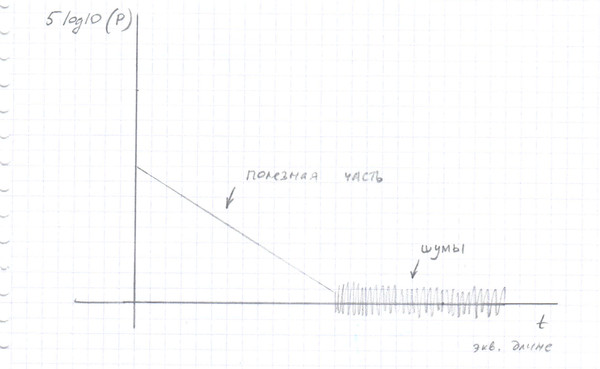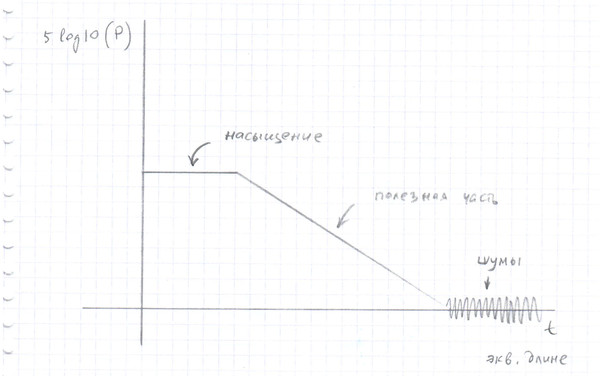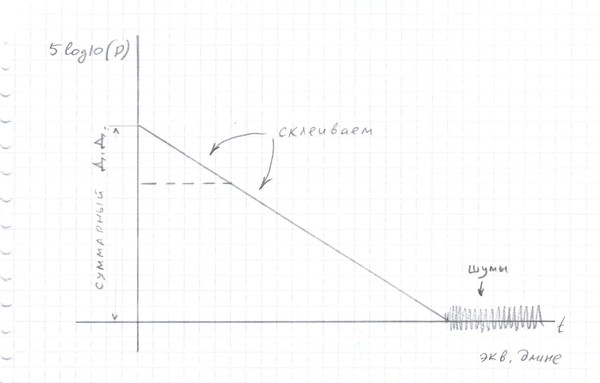Increasing the dynamic range when developing an optical reflectometer
Limited dynamic range is a property of almost any technology that we encounter in life. For example, buying headphones, we are faced with this concept. You also have to take this parameter into account when working with a photograph, both from film and digital.
And in optical reflectometry there is the same concept. In this area, the dynamic range is equivalent to how long the optical cable can analyze the OTDR. When analyzing optics in PON networks, it also plays a big role, since splitters with a large division factor create a large attenuation and an appropriate dynamic range is required to “see” the cable behind the splitter.
I (not one, of course, but in the group) happened to develop an optical reflectometer and I want to share my knowledge on this topic. Namely - an approach to increasing the dynamic range.
To begin with, a reflectometer with a dynamic range of 35/37 dB (meaning 1550 and 1310 nm, respectively) is no longer a rarity. The reflectometer displays on the screen the optical power calculated by the formula 5 * log10 (P / Po). Accordingly, the receiving part of the reflectometer (amplifier path) to operate in the power range from about 1 mW to (attention!) 0.1 nW (10 ^ -10 W). Seven orders of magnitude, 10e6! By the way, reflectometers are now being produced with a 42 dB range. How to achieve these characteristics?
')
The question of "pulling out" the signal from the noise (nanoWatts is a very small amount, comparable to the noise in the circuit) will not be considered here, since This is a topic for a separate discussion. And we will assume that the laser in our reflectometer is quite powerful, because it is so.
Now let's digress from a specific area (not everyone has to develop analog amplifiers with a high dynamic range) and move on to more understandable and visual things. Let's draw an analogy with a photo.
There is a similar problem in photography. A huge range of real-world brightness from light white to dark black cannot be transmitted by any carrier: either by film or by digital matrix. But you want to see a picture as close as possible to reality. Therefore, to achieve the desired result, an exposure fork is made - a series of frames is taken, each of which “covers” only a part of the real dynamic range. The resulting images are combined into a final image and as a result we have an image with an increased dynamic range.
There are quite a few articles on this topic, for example, see Wikipedia . With pictures.
The described approach is applied in reflectometry. The optical cable to which the reflectometer is connected in the process of measurements does not quickly change its characteristics. This allows the OTDR to take a lot of measurements, “study” the cable before the picture appears on the screen.
First, a series of measurements is made on the amplifier channel with a minimum gain. This amplifier “works out” the signal with high power. The weak signal does not fall within the range of this amplifier.

Then a series of measurements is carried out on the amplifier channel with a larger coefficient. This amplifier already “climbs” into the range of weaker signals, but loses information about a strong signal, since saturation occurs on a strong one. Note that the behavior is the same as the matrix / film in the photo.

And so on.
It turns out a set of dimensions that need to be combined with each other. Association is not a big problem, although it is difficult to call this algorithm simple, given the variation in the characteristics of the circuit. The gains are well known and those parts of the signal where saturation has occurred are well known.

And in optical reflectometry there is the same concept. In this area, the dynamic range is equivalent to how long the optical cable can analyze the OTDR. When analyzing optics in PON networks, it also plays a big role, since splitters with a large division factor create a large attenuation and an appropriate dynamic range is required to “see” the cable behind the splitter.
I (not one, of course, but in the group) happened to develop an optical reflectometer and I want to share my knowledge on this topic. Namely - an approach to increasing the dynamic range.
To begin with, a reflectometer with a dynamic range of 35/37 dB (meaning 1550 and 1310 nm, respectively) is no longer a rarity. The reflectometer displays on the screen the optical power calculated by the formula 5 * log10 (P / Po). Accordingly, the receiving part of the reflectometer (amplifier path) to operate in the power range from about 1 mW to (attention!) 0.1 nW (10 ^ -10 W). Seven orders of magnitude, 10e6! By the way, reflectometers are now being produced with a 42 dB range. How to achieve these characteristics?
')
The question of "pulling out" the signal from the noise (nanoWatts is a very small amount, comparable to the noise in the circuit) will not be considered here, since This is a topic for a separate discussion. And we will assume that the laser in our reflectometer is quite powerful, because it is so.
Now let's digress from a specific area (not everyone has to develop analog amplifiers with a high dynamic range) and move on to more understandable and visual things. Let's draw an analogy with a photo.
There is a similar problem in photography. A huge range of real-world brightness from light white to dark black cannot be transmitted by any carrier: either by film or by digital matrix. But you want to see a picture as close as possible to reality. Therefore, to achieve the desired result, an exposure fork is made - a series of frames is taken, each of which “covers” only a part of the real dynamic range. The resulting images are combined into a final image and as a result we have an image with an increased dynamic range.
There are quite a few articles on this topic, for example, see Wikipedia . With pictures.
The described approach is applied in reflectometry. The optical cable to which the reflectometer is connected in the process of measurements does not quickly change its characteristics. This allows the OTDR to take a lot of measurements, “study” the cable before the picture appears on the screen.
First, a series of measurements is made on the amplifier channel with a minimum gain. This amplifier “works out” the signal with high power. The weak signal does not fall within the range of this amplifier.

Then a series of measurements is carried out on the amplifier channel with a larger coefficient. This amplifier already “climbs” into the range of weaker signals, but loses information about a strong signal, since saturation occurs on a strong one. Note that the behavior is the same as the matrix / film in the photo.

And so on.
It turns out a set of dimensions that need to be combined with each other. Association is not a big problem, although it is difficult to call this algorithm simple, given the variation in the characteristics of the circuit. The gains are well known and those parts of the signal where saturation has occurred are well known.

Source: https://habr.com/ru/post/173843/
All Articles